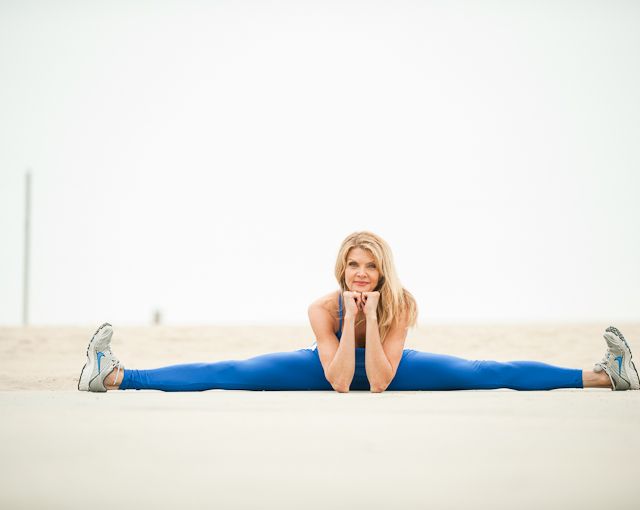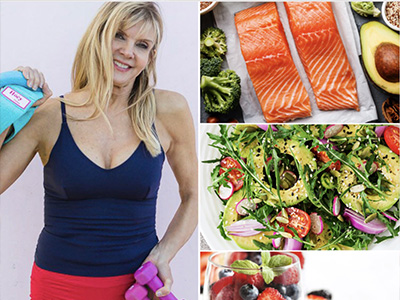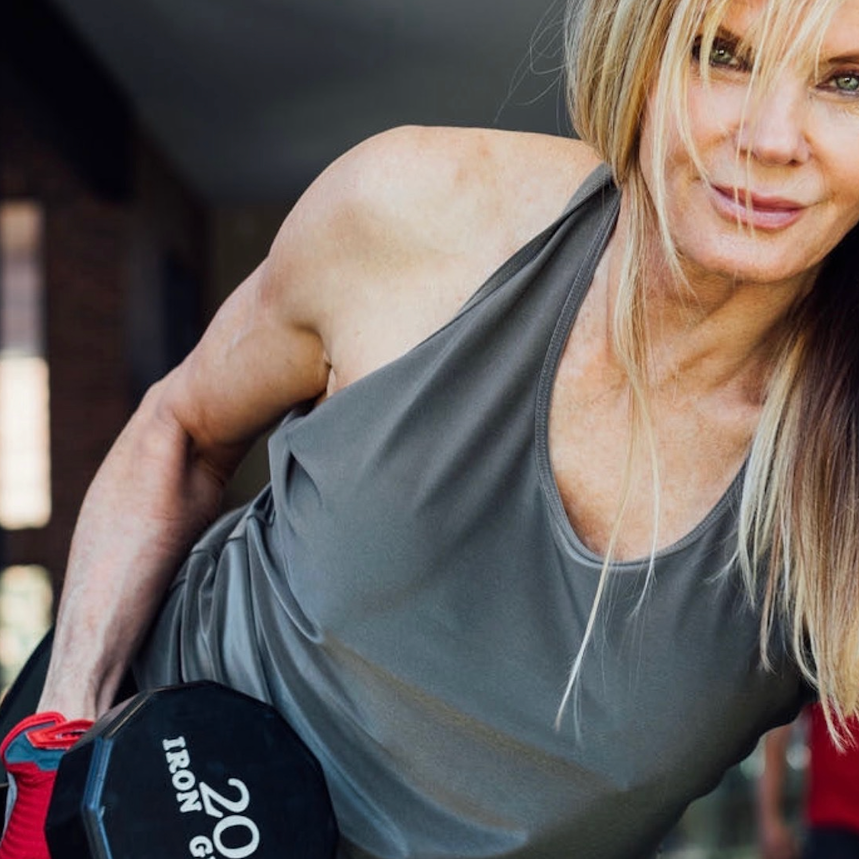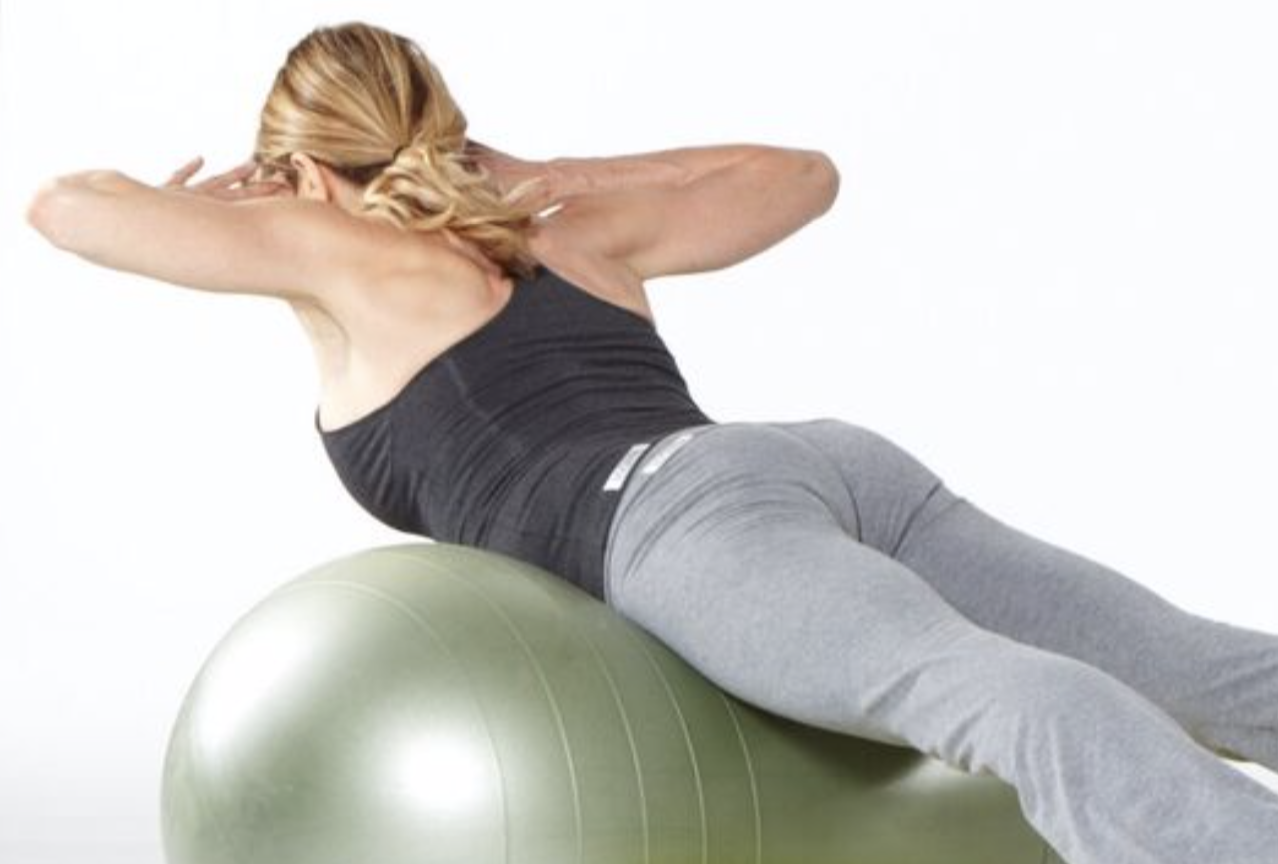For part 1, click here
N- Night Sweats
Night sweats are hot flashes that happen while you’re sleeping. At their worst, they can be a real trial; some women awaken drenched with sweat and have to change sheets and clothing. But even if you can’t climb into bed and get 8 hours of sleep right this minute, below is my “BLT,” an exercise you can do, to battle stress and minimize your chances of having night sweats. Studies have shown that paced breathing can lower your hot flash rate by 44%.
BLT stands for Breathing Listening Technique, and it’s just as simple as it sounds. You can try it, right now, wherever you are:
- Get comfortable in your chair. Make sure your shoulders are relaxed, down and back, and that your chest is nice and open.
- Take a nice, steady inhale on a count of 6.
- When you reach the top, try and hold it there for a count of 6. And while you’re holding your breath, listen. Try and identify any sounds around you, however distant or faint they may be: An air conditioner rumbling…A dog barking down the street…A car driving down the street…Or maybe just the soft song of a bird nearby. Whatever it is, be specific and mentally pinpoint the source of each sound.
- And then, slowly, exhale on another count of 6.
- Repeat this cycle 4-5 times.
O- Orgasm
Most women report some change in sexual function at menopause. Surveys show that women typically have fewer sexual thoughts, experience poorer lubrication, and may feel less satisfied with their partners as lovers.
The good news is that there are solutions:
- Educate yourself through books and videos about sexuality and sexual functioning.
- Realize that a satisfying and active sex life is possible at any age.
- Experiment with a different style of lovemaking, involving longer foreplay.
- Aggressively manage symptoms that interfere with sexual enjoyment, such as vaginal dryness, hot flashes, or chronic back or neck pain.
- Seek help from a psychotherpist or sex therapist to deal with relationship problems or dysfunction, or to figure out how to work around chronic physical problems.
- Getting into shape physically should help you feel sexier.
Try out this belly dancing move from my Flex Appeal DVD to lubricate your joints and improve the flow of energy throughout your body.
P- Perimenopause
A period of several years leading up to menopause during which you’re still menstruating, but are having fluctuations in estrogen levels that may produce hot flashes or other symptoms. Average age is about forty-seven but can start in your late thirties. It begins with dropping progesterone levels and ends with dropping estrogen levels. For most women, it’s a time when moods are unpredictable, expanding waist lines and declining energy. Here are some common signs that may indicate you’re experiencing perimenoapause:
- Feeling of emotional instability, that you may burst into tears for seemingly minor issues.
- Lack of satisfaction with your life
- A preference to be alone and not participate in social events
- Problem sleeping
- Waking up sweaty
- Sudden forgetfulness
[mwi_product sku=”MS-22161″ title=”true” title_tag=”h2″ desc=”true” img=”true” img_width=”200″ price=”true” type=”add” btn_color=”blue” btn_link=”button” cols=”3″/]
Q- Quiet Time
Stress is normal, but if you let it escalate and peak, it can start costing you sleep, or worse.
With stress – and, more importantly, our bodies’ response to stress – there’s a tipping point. And when we go past that point, we start to put our health at risk – in part because we begin to gain weight. There’s a strong connection between our nation’s obesity epidemic, and our skyrocketing stress levels. And the link is cortisol.
Cortisol is a hormone that’s triggered when we experience stress. So anytime we’re in a situation that activates our stress response, cortisol floods our bloodstream. And it’s bad news for several reasons. It’s a domino effect: High stress equals high cortisol levels, and high cortisol levels can lead to a whole host of issues, including depression, anxiety, and weight gain.
Here are a few of my favorite emergency remedies:
- Switching the car radio to a classical station—rock music and talk radio are designed to stir you up; sometimes that’s one stimulant too many.
- A cup of herbal chai tea at my favorite teahouse—this gives me fifteen or twenty minutes of restful quiet time while I sit and drink it.
- A hot bath (just be aware that hot baths can be a hot-flash trigger).
- A yoga class, or yoga in your living room. (Click here to try my yoga starter kit)
- Deep, rhythmic breathing — BLT
- Cooking.
- Juggling—I love it; it forces me to clear my thoughts and be in the present!
R- Relationships
When I turned 50 and began the move through perimenopause, the changes in my body mirrored significant changes in my life. At that time, I had recently gone through a separation and divorce. I saw my daughters poised at the brink of their teen years, knowing that soon they’d be pursuing independent lives. Like so many other women, I was trying to make sense of all the changes, and set meaningful goals for this new era. One of the most exciting outcomes of the sense of freedom I felt was the rediscovery of my female friends, who all seemed to re-emerge as the demands of family-raising ease. I realized how important these relationships are, and will continue to be.
S- Strength training exercises
Performing regular strength-training exercises will help preserve bone density while also improving sleep. Strength training and aerobic exercise have been shown to improve sleep. Don’t overexert immediately before bedtime, however. If possible, try to exercise no later than the early evening.
Try my Lift Weights To Lose Weight DVD set for my favorite strength training exercises:
[mwi_product sku=”LWLWSET” title=”true” title_tag=”h2″ desc=”true” img=”true” img_width=”200″ price=”true” type=”add” btn_color=”blue” btn_link=”button” cols=”3″/]
T- Testosterone
There are many types of hormone replacement therapy involving estrogen and progesterone, either separately or in combination. Sometimes testosterone is prescribed as well. Some formulas give you a monthly period, others don’t. Hormone therapy is available in many forms, including pills, patches, creams, drops, and injections. Some formulas are aimed at improving symptoms; some are designed only to strengthen your bones and heart; still others do both. The choice of hormone will depend on your needs, and finding just the right formula and dose for your body can be a trial-and-error process. Therefore it’s best to work with a specialist when it comes taking to any hormones.
U- Universal Themes of Menopause
In the end of my research for Moving Through Menopause, I realized that there are three universal themes of menopause. First, the immediate hormonal symptoms, such as hot flashes and mood swings; second, the need to reexamine your life and find a deeper sense of meaning; and, finally, long term health issues, specifically heart disease and bone loss. I think every woman should consider these areas, and talk with her doctor about them. Just remember, again, that the scientific information is always being updated. For that reason, it’s a good idea to see a specialist. The doctor that delivered your baby may not be up on the latest research concerning menopause and hormone replacement.
V- Vitamin C
Vitamin C gives your adrenals a boost, which will help with fatigue and may boost bone mineral density. In a study in the Journal of Bone and Mineral Research, researchers concluded that vitamin C appeared to enhance the effects of estrogen therapy and calcium supplements. Women who took 1,000 milligrams or more of the vitamin C had higher levels of bone density than those who took less. Vitamin C has also been shown to lower cortisol levels in stressful situations.
W- Wrinkles
One of the liberating things about this stage of life is that you get to readjust your priorities a bit. What’s important now isn’t cosmetic perfection, it’s how well your body works, as well as what it says about your inner self, through qualities like posture and energy. Sure, I notice little signs of aging in my body just like everyone else. Rather than obsessing over them, though, I use them as a reminder to put more effort into things I still have control over—my physical strength and stamina, my relationships, and my place in the world.
When I started going through perimenopause, I noticed that my skin was more dry than before. After trying every moisturizing cream on the market, I found a winning combination of what you put in your body, and what you put on your skin. Afater trying every moisturizing product on the market, I discovered Real Face Food, a jojoba-based serum that eliminated dryness, which is truly a wonder in a high altitude climate like mine! I also increased my intake of healthy fats and incorporating fish into my meals at least twice a week.
The American Heart Association recommends eating certain types of fish at least twice a week (see below list). Why? Because fatty fish are high in omega-3 fatty acids, which may work wonders on your cardiovascular system and lower your cholesterol, reduce inflammation, improve arthritis, and even improve learning ability, not to mention improving skin quality! In October 2009, Seafood Watch, a program run by the Monterey Bay Aquarium in California, combined data from leading health organizations and environmental groups to come up with the list “Super Green: Best of the Best” Seafood. To make the list fish had to a) be low in contaminants b) high in omega-3s and c) come from a sustainable fishery. Look for the MSC Blue eco label for a more conscious choice.
The Six Best Fish Include:
- Albacore tuna
- Farmed Mussels & Oysters
- Pink Shrimp from Oregon
- Farmed Rainbow Trout
- Salmon (wild-caught, Alaska) – strict regulations and quotas ensure that Alaskan salmon are both healthier and more sustainable.
- Sardines, Pacific (wild-caught) – naturally high in vitamin D and 3oz. of sardines contain 1,950mg of omega-3s!
The Six Worst Fish include:
- Bluefin Tuna
- Chilean Sea Bass
- Groupers
- Monkfish
- Orange Roughy
- Salmon (farmed)
X- X-Treme Heat
If you find you’re always the one asking whether it’s “hot in here,” you’re not alone. Hot flashes, or flushes, are the classic emblem of menopause, and, in this country at least, they affect up to 80 percent of all women.
A hot flash happens when the part of your brain that regulates body temperature gets the mistaken idea that you’re too hot. In response, your body follows its normal procedure for cooling itself, exactly as it would if you were overheated: Your heart rate speeds up, your face turns red as blood moves toward the skin’s surface, and you may break out in a sweat. Hot flashes are often followed by a chill, as your body temperature stabilizes again.
Every woman tends to have her own pattern of flashes. These can vary enormously, but they average about three and a half minutes, and usually happen three to four times a day.
The first line of defense against hot flashes is to address the triggers. This means:
- Dressing in layers
- Switching from steaming lattés to iced herbal drinks
- Using breathable 100% cotton bedding and sleepwear
- Reducing your stress through progressive relaxation, yoga, meditation, or other means (all are discussed in chapter 10 of Moving Through Menopause)
Meanwhile, inventive women have developed dozens of strategies for keeping their cool: Portable spritz fans, for instance, combine a spritzer bottle with a handheld fan. Some women install a ceiling fan over their bed. One woman I know soaks her socks in water before wearing them to bed: The water evaporates as she sleeps and helps keep her cool. In general, turning down the thermostat will help, especially at night.
Y- Yoga
Throughout perimenopause and menopause, keeping up a yoga program and other stress-reducing techniques can help keep you centered and calm. To help calm your mind, try this yoga sequence from my yoga kit:
Z – Zzz’s
I highly recommend paying attention to your sleeping patterns. Sleep is a pivotal aspect of menopause. Changing hormonal levels and symptoms like hot flashes can disrupt good sleep and leave you feeling more vulnerable the next day. To make matters worse, lack of sleep saps your energy, making it harder to exercise, thereby robbing you of the stress-reducing benefits of physical activity. That’s why I say anything you can do to improve your sleep will help you across the board. Of course, I’ve included a number of sleep-enhancing strategies in my book.
Here a few tips that Mayo Clinic suggests for getting better sleep:
“1. Stick to a sleep schedule
Go to bed and get up at the same time every day, even on weekends, holidays and days off.
2. Pay attention to what you drink
Don’t go to bed either hungry or stuffed. Your discomfort might keep you up.
Nicotine, caffeine and alcohol deserve caution, too. The stimulating effects of nicotine and caffeine — which take hours to wear off — can wreak havoc with quality sleep. And even though alcohol might make you feel sleepy at first, it can disrupt sleep later in the night.
3. Create a bedtime ritual
Do the same things each night to tell your body it’s time to wind down. This might include taking a warm bath or shower, reading a book, or listening to soothing music — preferably with the lights dimmed.
4. Get comfortable
Create a room that’s ideal for sleeping. Often, this means cool, dark and quiet. Consider using room-darkening shades, earplugs, a fan or other devices to create an environment that suits your needs.” (Source: http://www.mayoclinic.com/health/sleep/HQ01387)
Get your copy of Moving Through Menopause in my Menopause Kit today!







Want moving through menopause download book. Already have DVD. Want to know how to buy ebook only.
Sent email asking before but never received answer! So sad!
Hi Jane! The e-book is available on its own at: http://www.kathysmith.com/store/moving-through-menopause-ebook
I don’t either and I love Kathy. I can’t understand why there is no answer, as I am very frustrated and need help
Hi Debbie! The e-book is available on its own at: http://www.kathysmith.com/store/moving-through-menopause-ebook
Thank you Ms. Smith! Your pregnancy workout was a lifesaver for me! I just wanted to let you know that under the paragraph Wrinkles above there’s a sentence with ‘after’ misspelled: “Afater trying every moisturizing product on the market, I discovered Real Face Food, a jojoba-based serum that eliminated dryness, which is truly a wonder in a high altitude climate like mine!”